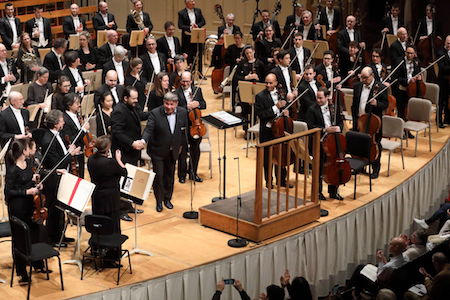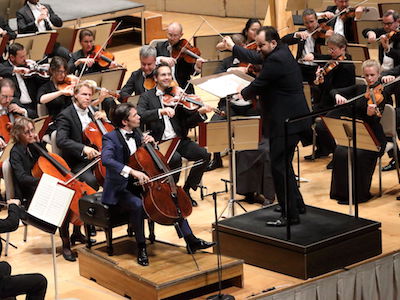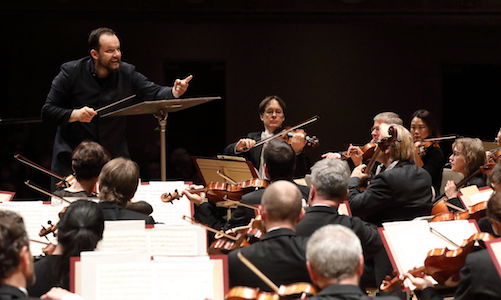Two concerts
|
Grant Chu Covell [December 2019.]
Gustav MAHLER: Blumine (1889-93). Robert SCHUMANN: Cello Concerto in A minor, Op. 129 (1850)*. Richard WAGNER: Overture to The Flying Dutchman (1843). Felix MENDELSSOHN: Symphony No. 3 in A minor, Op. 56, “Scottish” (1829-42). Gautier Capuçon* (vlc), Leipzig Gewandhaus Orchestra, Andris Nelsons (cond.). October 29, 2019, 8:00 p.m., Symphony Hall, Boston. (http://www.bso.org/). Arturs MASKATS: “My River runs to thee…” (2019). Pyotr TCHAIKOVSKY: Violin Concerto (1878). Dmitri SHOSTAKOVICH: Symphony No. 2, “To October,” Op. 14 (1927). Daniel Lozakovich (vln), Tanglewood Festival Chorus, James Burton (cond.), Boston Symphony Orchestra, Andris Nelsons (cond.). November 22, 2019, 8:00 p.m., Symphony Hall, Boston. (http://www.bso.org/). Some concerts are like encyclopedias or history lessons. These are events where the program unspools in front of an audience, and where a genre or period is presented for examination. Such was the evening of October 29 when the Leipzig Gewandhaus Orchestra (Gewandhausorchester Leipzig or GHO) offered Mahler, Schumann, Wagner and Mendelssohn before an appreciative crowd. That Mahler and Wagner shared the concert with each other and with other music is startling given their accustomed loquaciousness. We heard the abandoned Blumine movement from Mahler’s First and the overture to The Flying Dutchman. Between Mahler and Wagner, Gautier Capuçon joined the LGO in Schumann’s Cello Concerto, and the evening concluded with Mendelssohn’s Third. It astounds to consider the linkage between these composers and the Leipzig orchestra. Mahler had been working at his Symphony No. 1 while apprenticed to Arthur Nikisch at the Leipzig Opera. Schumann lived and worked in Leipzig for a spell. Wagner was born in Leipzig. Mendelssohn premiered his “Scottish” symphony with the GHO in 1842 when he was its music director. The connections between Leipzig and Boston run deep. Back in the day, musicians studied in Leipzig or Dresden, and several BSO conductors worked in Leipzig (Arthur Nikisch, Emil Paur, et al.).
Heard infrequently, Mahler’s Blumine can charm. Given our current four-movement bias, it is inconceivable how this short sunny piece could fit within the heroic First. The GHO did not dawdle with the Mahler but invested in a fine presentation of Schumann’s impetuous Cello Concerto. Penned in a two-week burst in October 1850, this concerto’s structure does not yield as easily as the Piano Concerto. Capuçon acquitted himself well. The Wagner Overture was a fluid thunderbolt; I wondered why the evening had not started here. It did sound as if the GHO had more fluency with the Wagner whose pacing and balances were well defined. The concluding Mendelssohn, not just because it has a special place in the GHO repertoire, was winning and particularly masterful. If the Oct. 29 concert was an organized encyclopedia, the concert of Nov. 22 was a kitchen junk drawer littered with bits of string, broken pencil stubs and expired coupons. The centerpiece was Tchaikovsky’s Violin Concerto, a perennial crowd pleaser, with Daniel Lozakovich, soloist. Nelsons and the BSO offered a measured Classical accompaniment. The teenage soloist executed perfectly but said little; I’d like to hear Lozakovich again in a decade or two. The concert also featured the Tanglewood Festival Chorus and opened with a premiere. I am glad to see the BSO commissioning new works (this was a co-commission with the GHO). Arturs Maskats was born in Latvia in 1957. He and Nelsons were colleagues at the Latvian National Opera, and his 2019 piece, “My River runs to thee…” was written in memoriam for a mutual colleague, Andrejs Žagars.
I hear plenty of lackluster contemporary music without feeling a need to comment, but Maskats’ “My River runs to thee…” warrants scrutiny. No one should write such an uninteresting and outdated piece in 2019. I cannot believe the BSO performed it; they are lowering the bar for premieres and providing ready ammunition for those who don’t see the point of new music. The poetry of Emily Dickinson provided the impetus for this quarter-hour span of blandness. The harmonies are outdated and dreary. The orchestration is uninteresting when it isn’t annoying (a repeating tedious temple block gesture frames the work). There is nothing of melodic or material interest to capture our attention. Maybe this would have been more interesting decades ago, perhaps as a mid-20th-century film score. The BSO is working its way through all 15 of Shostakovich’s symphonies for their DG cycle. This concert closed with the rarely performed Symphony No. 2. There is a good reason Shostakovich’s Second is unfamiliar. An impractical chunk of agitprop for chorus and orchestra that feels like a hastily completed school assignment, we find the composer running the gamut from noise to harangue. Shostakovich was a naïve lad, not quite 21, and it’s possible he believed he had unlimited artistic license. However, his world would come crashing down nine years later, in 1936, during the run of his initially successful opera Lady Macbeth of the Mtsensk District when Stalin singled him out as a formalist. Shostakovich’s music after 1937, from the Fifth Symphony onwards, is perhaps chastened; he did thereafter live in fear of his life. But in 1927, to celebrate the 10th anniversary of the October revolution, Shostakovich could be glib and sloppy. Other Futuristic Russian pieces reflected industrialization’s potential and sought to replicate the modern world, such as Alexander Mosolov’s Iron Foundry (which was premiered on a concert that included a performance of Shostakovich’s Second). Perversely patriotic, “To October” includes a factory siren (which sounded like a synthesizer or tape here), but offers little novelty and fails to inspire. [Ovation for the world premiere of Arturs Maskats’ “My River runs to thee…” with the composer and Andris Nelsons, photo by Hilary Scott; Andris Nelsons, the GHO, and cellist Gautier Capuçon perform Schumann’s Cello Concerto at Symphony Hall, photo by Hilary Scott; Andris Nelsons and the Leipzig Gewandhaus Orchestra in Mendelssohn’s Symphony No. 3, photo by Hilary Scott.]
[More Grant Chu Covell]
[Previous Article:
Used Bin Troll Tweets NN.]
[Next Article:
Mostly Symphonies 36.]
|


